Guillemots 2020
The Guillemots had a successful year and were packed onto the ledges. Through the cliff camera we were able to record some of the footage, including the very sad end to a young , a natural process - but not for the faint hearted!
The last Guillemots on the empty ledges at the end of the breeding season, with a Shag in silhouette
Chicks jumping (evening 16th June) - oh not already! - look for the small chicks on the left edge of the frame if you are struggling to see them!
10 day old chick (8th June) Cute or what!!
Chicks and more 1st June
First Chick has hatched : 24th May - video here
From 18th May - Focus on Razorbills as well as Guillemots
From 9th May - see the numbers, spot the egg.
Taken Tues 5th May 2020 - Guillemots packed on the upper ledge, I counted 192 on Monday evening, so numbers are good. The seaward end used to be almost empty 20 years ago, now it has an extra 40 or so birds
Taken Fri 1st May
Taken on 30th April 2020 from our cliff camera and shows the Guillemots on the ledges with eggs, some of which are bright blue.
The eggs will be hatching around the 25th May (with luck).
Guillemots 2019
The ledges have been full of birds this season. This photo was taken through the cliff camera on 25 June 2019.

Guillemots 2014
The Lower ledge remained a successful breeding ground for the Guillemots, with more adults squashed on than in previous years, whether this is a result of the displacement from the upper ledge or natural increase can not be ascertained. The Upper ledge again produced no chicks at all with all the eggs removed by the Ravens earlier in the season. The displaced adults spent the season on the water and the ledge but never settling. On one occasion a Raven was seen to attack a Guillemot, standing on it and pulling feathers off its breast, the Guillemot did escape but was not identified again
Guillemots 2013
This was another very poor breeding season, with not a single chick succesfully fledging from the upper ledge, once again due to the predation by a family of Ravens. The Lower ledge continues to be productive with chicks fledging, over 50 sites were identified and at least 30 chicks fledging. This is an under estimate as the watching and recording of this ledge was reduced
Guillemots 2012
It was a very very poor breeding season at Durlston due entirely to the predation of the upper ledge by a family of Ravens. On one morning 9 eggs were taken in a 30 minute period. The ledge was emptied of eggs, chicks and adult Guillemots by the activity of the Ravens. Only 3 chicks fledged from the upper ledge were the recent numbers have been 80+ chicks.
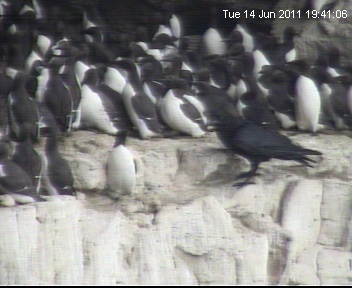
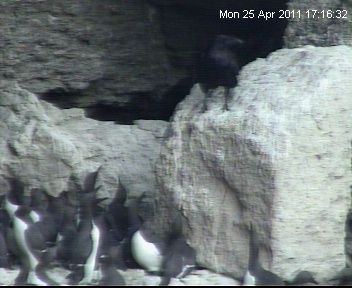
Guillemots 2011
Another successful breeding season, with well over 65 identified sites - where pairs of Guillemots are present throughout the breeding season. The first egg was laid on 15th April (but subsequently lost), the first chick hatched 20th May and the first fledge noticed was 13th June. All the birds had left the ledges by early July.
During the main seaon the number of birds counted on the upper ledge averaged at 260, with the maximum count on 17th Feb of 333 birds.
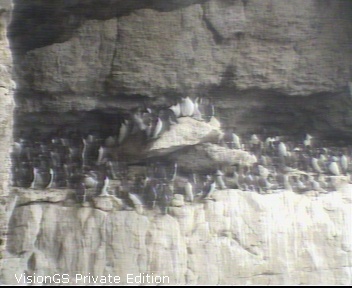
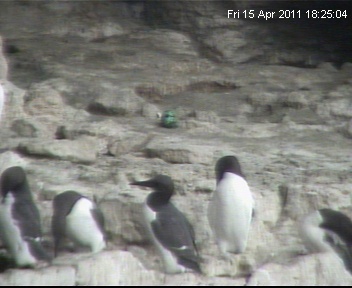
A few unusual incidents were noted, including predation by corvids, with Crow and Raven both seen trying to steal eggs from the ledge.
Guillemots 2010
Another successful breeding season, with well over 50 chicks fledged. The first were laid on 24th April and the first chicks hatched 24th May. All the birds had left by early July.
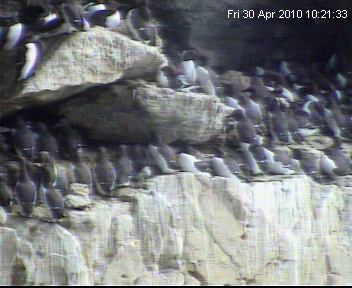
Guillemots 2009
The cliff camera was returned to the cliffs on 19th February. 324 Guillemots were counted on the upper ledge on 28th Feb - the maximum so far for the year.
Sad News: Tufty has not returned this year, after being here for at least 16 successive years.
Good News: The first eggs were laid on 22nd April, the first chick hatched 23rd May, and 64 chicks were identified as part of the breeding survey. All the chicks have now left the ledges. The adult Guillemots will return to Durlston occasionally from October onwards.
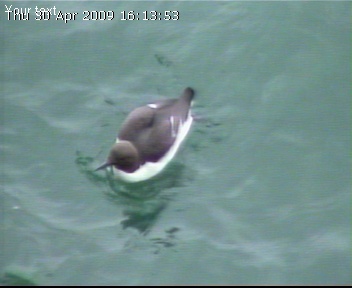
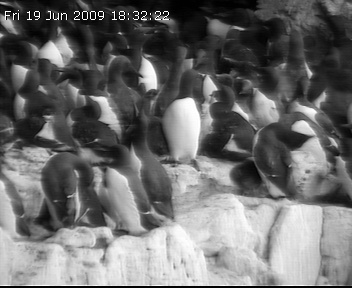
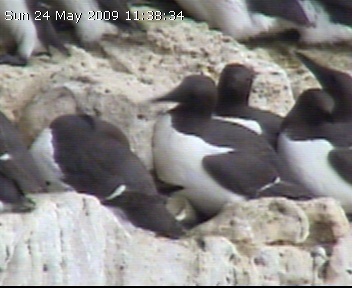
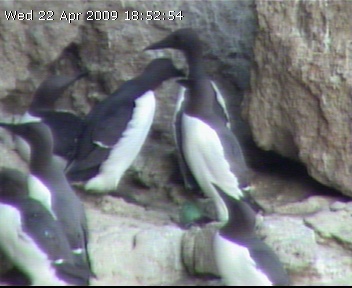
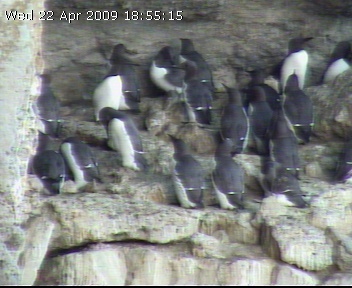
Guillemots 2008
Highlights only - download the full report here
A count on the 10th April saw 343 on the upper ledge and a further 89 on the lower ledge.
These numbers include "Tufty", 1 bridled and 1 'speckled' bird - the head plumage has not fully changed from the winter white to the breeding brown. Tufty again returned to his territory and successfully hatched and fledged a chick. The first chick was due 26th May.
We ran breeding and feeding studies this year, including 'dawn to dusk' watches on both 5th & 9th June.
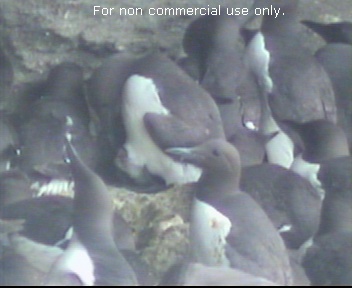
Guillemots 2007
The Guillemots had another successful breeding season with over 50 chicks recorded, the majority of which fledged the ledge successfully. However 3 were seen to be taken by predatory Great Black-backed Gulls. The last Guillemots left 8th July 2007.
|
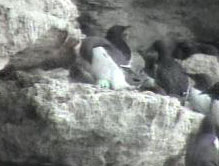
First egg seen through cliff camera on 24th April 2007
|
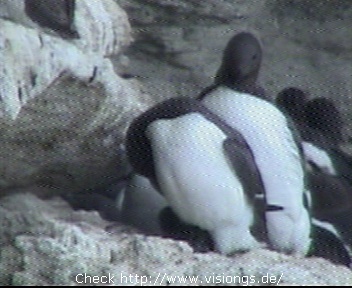
First chick (25th May 2007) - probably hatched on 24th May
|
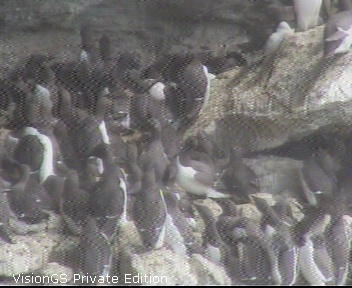 |
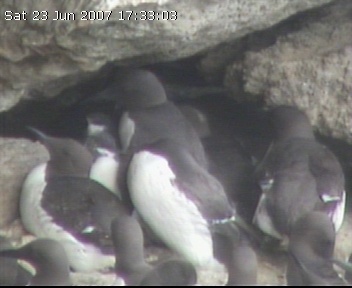 |
|
Guillemots 20th May 2007
|
Chicks and Tufty - white splodge on back of head in background of picture!
|
Guillemots 2006
COMMON GUILLEMOT Uria aalge
Is a common coastal resident, winter visitor and offshore passage migrant.
The annual seabird counts recorded 602 Guillemots at Durlston. The records which follow were observations from the cliff camera. The first record of the year was on 3rd January, when 220 birds were counted on the upper ledge (including ‘Tufty’, one bridled bird and a few in winter plumage). The average of subsequent counts was 194 birds on the upper ledge and 32 on the lower, making a total of 226. This is lower than in 2005 but the frequency of counts was greatly reduced in 2006. The maximum count was on 27th February with 240 birds on the upper ledge and 73 on the lower. Birds visited regularly between January and March, with permanent occupation from 16th April. The first egg was laid on 24th April and the first chick was seen on 29th May (two eggs were abandoned and three chicks at least failed to fledge at the end of season). Unusually, a very late chick was present on the lower ledge until 19th July.
No birds were seen in the area from then until 20th November. From 20th November, they were recorded on or around the ledges for 21 days. Virtually all of these birds were in breeding plumage by this time. Unfortunately, the camera lost its wiper this year and the study had to be abandoned from the start of June because of lack of visibility.
Guillemots 2005
The years Guillemot study was undertaken at Durlston Country Park through the remote camera positioned on the cliff. Records of presence or absence in the early morning were taken throughout the year from the cliff looking back at the upper ledge. The lower ledge is not visible from the cliff and on many occasions birds were present on the water and flying in the area, when not recorded on the ledge.
Video and DVD images were recorded during the year providing additional information
Summary of results of upper Ledge Survey
Max count on upper ledge = 330
Average count of upper ledge = 224
Number of Eggs = 61
Number of Chicks Hatched = 59
Number of Chicks Fledged = 52
Breeding productivity = 85%
Summary of Events by Date
|
Date
|
|
|
|
22/11/04
|
40+ adults on ledge
|
|
|
27/11/04
|
No birds on ledge
|
|
|
Dec 04
|
14 early mornings on ledge
|
|
|
01/01/05
|
Guillemots on ledge
|
|
|
09/02/05
|
Guillemots on ledge
|
|
|
09/03/05
|
Guillemots on ledge again after 24 days
|
|
|
11/03/05
|
Guillemots on ledge – 2 bridled and Tufty
|
|
|
05/04/05
|
Adult bird caught ankle in crack on ledge, unable to escape, died – details of bird collected
|
Sheet 1, dvd 1
|
|
10/04/05
|
Guillemots back on ledge all day from this day on
|
|
|
12/04/05
|
314 adults on upper ledge, 84 lower ledge. 5 Bridled and ‘Tufty’
|
|
|
26/04/05
|
269 upper
|
|
|
02/05/05
|
First egg seen
|
|
|
06/05/05
|
20 eggs counted
|
|
|
22/05/05
|
52 eggs counted. 220 adults, 5 bridled and Tufty
|
|
|
30/05/05
|
First Chick – 3 chicks seen
|
|
|
07/06/05
|
28 chicks counted
|
|
|
16/06/05
|
59 chicks, including Tufty’s chick
|
|
|
20/06/05
|
First chick left ledge
|
|
|
22/06/05
|
204 adults
|
|
|
05/07/05
|
84 adults
|
|
|
07/07/05
|
51 adults , 3 chicks upper ledge
|
|
|
08/07/05
|
49 adults, 2 chicks upper
|
|
|
09/07/05
|
4 adults, 1 chick upper
|
|
|
10/07/05
|
No adults or chicks upper
|
|
|
14/07/05
|
Last chick on lower ledge
|
|
|
15/07/05
|
No Guillemots on ledges or water
|
|
Guillemots 2004
This Guillemot colony is the most easterly on the south coast of Britain and at the edge of the birds geographical range. In 1993 a camera was set up on the cliffs to monitor this colony. 2003 was to have been a year of detailed study with Breeding and Feeding surveys being undertaken during April, May and June. This would have allowed a comparison with the start of the study, and analysis of 10 years of results (the camera failed in one year).